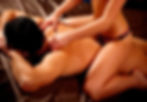Incall Wan Chai, Outcall Massage Hong Kong, Independent, Role-play, Mistress

Cervical Spondylosis Massage Hong Kong, Cervical Spondylosis Massage Near Admiralty, Pacific Place, Central, Mid Levels, Sheung Wan, Causeway Bay
Computers have made it to most everyone’s desks at work and at home. Add to that, tablets and smartphones and we find ourselves peering at a screen all day long. In most cases our heads are tilted down which causes strain on the neck and shoulder muscles. This leads to stiffness and pain.
The human head weighs about 10-12 pounds, and the head tilts forward about 15 degrees. At that angle, the weight of the head supported by the cervical bone increases to 27 pounds. When you are looking down with your head tilted forward at about 60 degrees the stress on the cervical bone increases to around 60 pounds. This potentially can lead to cervical spondylosis.
There are a total of 7 cervical vertebrae in the human body, and 8 pairs of cervical nerves pass through the intervertebral foramen between the two cervical vertebrae; the spinal cord passes through the foramen to the thoracic and lumbar vertebrae; there is a vertebral artery on the left and right of the cervical vertebrae to supply blood to the brain. Once the soft tissues of the neck (such as intervertebral discs and ligaments) degenerate, the spine is squeezed, and nerves and blood vessels are compressed, which can cause discomfort, known as cervical spondylosis.
Massage is effective in treating symptoms of cervical spondylosis because it can balance and relax the muscles that support the cervical spine and is helpfulfor patients with spondylitis who commonly have muscle spasm and loss of flexibility. However, Massage should not be administered to anyone who is experiencing acute inflammation resulting from spondylosis. It is best to consult your physician, before seeking massage, to make sure it will be beneficial.
There are several types of cervical spondylosis:
Cervical Spondylosis
Cervical Spondylosis is the mildest condition. Patients will have headaches, pain in the posterior occipital region and stiff neck muscles. They can usually be relieved by rest and massage
Nerve root type
Cervical nerve root compression can cause headache, neck and shoulder pain, neck stiffness, and even restricted movement. Sometimes the pain starts from one or both shoulders and gradually spreads to the arms and fingers. In addition, some patients may also have symptoms of finger numbness, cold upper limbs, and weakness.
Spinal cord
Depending on the degree and location of spinal cord compression, patients may experience numbness, soreness and weakness in the upper or lower limbs, and may even experience mild paralysis (eg, unstable walking and movement disorders).
Vertebral artery type
When the patient's vertebral artery is compressed, the brain's insufficient blood supply will feel dizzy, nausea and vomiting, and even faint suddenly; in addition, there will be tinnitus and blurred vision.
Sympathetic
This symptom may cause symptoms such as back occipital pain, dizziness, dizziness, chest tightness, cold limbs, or fever of the hands, feet, and heart due to sympathetic nerve stimulation.
